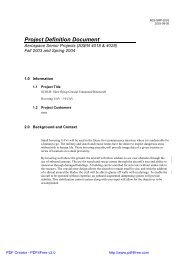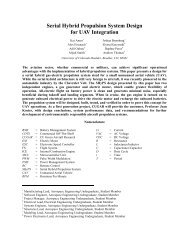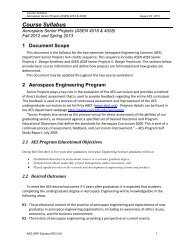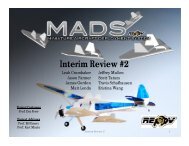PFR - Aerospace Engineering Sciences Senior Design Projects ...
PFR - Aerospace Engineering Sciences Senior Design Projects ...
PFR - Aerospace Engineering Sciences Senior Design Projects ...
Create successful ePaper yourself
Turn your PDF publications into a flip-book with our unique Google optimized e-Paper software.
Project Final Report – CUDBF April 30 th , 2009<br />
ASEN 4028: <strong>Aerospace</strong> <strong>Senior</strong> <strong>Projects</strong><br />
The cruise power was estimated to be 350W. Assuming an average battery pack voltage of 1.0V<br />
per cell (24.0V) during the discharge, an approximate amp draw of 15 amps was required to<br />
generate 350W of power. While the batteries are designed to hold 1500mah of power, the<br />
batteries cannot discharge this amount when discharged under such high amp draw (10C).<br />
Therefore, it was assumed that only 1000mah of actual usable power could be drawn from the<br />
battery pack before the power would drop off below a usable level. The rest would be dissipated<br />
as heat from the internal resistance of the battery cells. With an average amp draw of 15 amps<br />
and 1000mah of usable power, the calculated endurance of the battery pack at cruise speed<br />
would be 4:00.<br />
The plots in Figure 113 show the battery pack voltage and power consumption as a function of<br />
time.<br />
34<br />
Battery Voltage<br />
1200<br />
Power Usage<br />
32<br />
30<br />
1000<br />
Battery Voltage (V)<br />
28<br />
26<br />
24<br />
22<br />
Power Usage (W)<br />
800<br />
600<br />
400<br />
20<br />
18<br />
200<br />
16<br />
0 50 100 150 200 250 300 350 400<br />
Time (seconds)<br />
0<br />
0 50 100 150 200 250 300 350 400<br />
Time (seconds)<br />
Figure 113: Battery Voltage and Power Over Time<br />
The results of the test indicate that the battery pack voltage dropped below 0.9 V/cell at 4<br />
minutes 10 seconds into the test, and then the power dropped below the 350 W required for<br />
cruise flight. This was slightly higher than the 4 minutes predicted because the battery pack<br />
provided about 1050 mah of usable power, above the 1000 mah used in the initial assumptions.<br />
Based upon the assumption of one minute per lap, this test verifies that the Buff-2 Bomber can in<br />
fact fly four laps in cruise with the heaviest payload configuration. The battery pack continues to<br />
provide sufficient power to sustain a slow descent until 4 minutes 30 seconds into the test, when<br />
the power drops below 200W. This extra power margin was designed to be used as reserve<br />
power during flight.<br />
13.1.3 Structures Subsystem Verification and Validation<br />
A whiffle tree test was performed to determine whether or not the Buff-2 Bomber wing can<br />
sustain the expected loads seen in flight. The wing was loaded using a whiffle tree system and<br />
mounted upside down to simulate lift in flight. A right wing half was built according to normal<br />
construction spec in order to correctly determine the actual strength of the wing. The wing half<br />
133
















